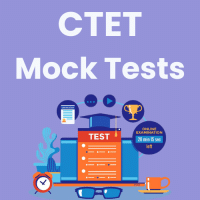CTET & State TET Exam > CTET & State TET Questions > Directions: Identify the part of speech of th...
Start Learning for Free
Directions: Identify the part of speech of the word underlined in the following sentence.
He bought a gold ring for his wife.
He bought a gold ring for his wife.
- a)Noun
- b)Adjective
- c)Pronoun
- d)Conjunction
Correct answer is option 'B'. Can you explain this answer?
Most Upvoted Answer
Directions: Identify the part of speech of the word underlined in the ...
Part of Speech in the sentence: Adjective
Explanation:
- In the given sentence, the word "gold" is underlined.
- To determine the part of speech of this word, we need to analyze its function in the sentence and its characteristics.
- The word "gold" is describing the type of ring that was bought. It is providing additional information about the ring.
- Adjectives are words that describe or modify nouns or pronouns, providing more information about them.
- In this sentence, "gold" is describing the noun "ring", specifying that the ring is made of gold.
- Therefore, "gold" functions as an adjective in this sentence.
Additional Information:
- Adjectives can come before or after the noun they modify.
- In this sentence, the adjective "gold" comes before the noun "ring".
- Adjectives can also be used to compare or quantify nouns, show possession, or indicate a specific number or order.
- Examples of other adjectives include "beautiful", "tall", "expensive", "four", "my", etc.
- Adjectives can be used to provide more information about the color, size, shape, quality, or other characteristics of a noun.
- They make the sentence more descriptive and help to create a clearer picture in the reader's mind.
Explanation:
- In the given sentence, the word "gold" is underlined.
- To determine the part of speech of this word, we need to analyze its function in the sentence and its characteristics.
- The word "gold" is describing the type of ring that was bought. It is providing additional information about the ring.
- Adjectives are words that describe or modify nouns or pronouns, providing more information about them.
- In this sentence, "gold" is describing the noun "ring", specifying that the ring is made of gold.
- Therefore, "gold" functions as an adjective in this sentence.
Additional Information:
- Adjectives can come before or after the noun they modify.
- In this sentence, the adjective "gold" comes before the noun "ring".
- Adjectives can also be used to compare or quantify nouns, show possession, or indicate a specific number or order.
- Examples of other adjectives include "beautiful", "tall", "expensive", "four", "my", etc.
- Adjectives can be used to provide more information about the color, size, shape, quality, or other characteristics of a noun.
- They make the sentence more descriptive and help to create a clearer picture in the reader's mind.
Community Answer
Directions: Identify the part of speech of the word underlined in the ...
'Gold' has been used as an adjective for the 'ring' here.

|
Explore Courses for CTET & State TET exam
|

|
Question Description
Directions: Identify the part of speech of the word underlined in the following sentence.He bought a gold ring for his wife.a)Nounb)Adjectivec)Pronound)ConjunctionCorrect answer is option 'B'. Can you explain this answer? for CTET & State TET 2025 is part of CTET & State TET preparation. The Question and answers have been prepared according to the CTET & State TET exam syllabus. Information about Directions: Identify the part of speech of the word underlined in the following sentence.He bought a gold ring for his wife.a)Nounb)Adjectivec)Pronound)ConjunctionCorrect answer is option 'B'. Can you explain this answer? covers all topics & solutions for CTET & State TET 2025 Exam. Find important definitions, questions, meanings, examples, exercises and tests below for Directions: Identify the part of speech of the word underlined in the following sentence.He bought a gold ring for his wife.a)Nounb)Adjectivec)Pronound)ConjunctionCorrect answer is option 'B'. Can you explain this answer?.
Directions: Identify the part of speech of the word underlined in the following sentence.He bought a gold ring for his wife.a)Nounb)Adjectivec)Pronound)ConjunctionCorrect answer is option 'B'. Can you explain this answer? for CTET & State TET 2025 is part of CTET & State TET preparation. The Question and answers have been prepared according to the CTET & State TET exam syllabus. Information about Directions: Identify the part of speech of the word underlined in the following sentence.He bought a gold ring for his wife.a)Nounb)Adjectivec)Pronound)ConjunctionCorrect answer is option 'B'. Can you explain this answer? covers all topics & solutions for CTET & State TET 2025 Exam. Find important definitions, questions, meanings, examples, exercises and tests below for Directions: Identify the part of speech of the word underlined in the following sentence.He bought a gold ring for his wife.a)Nounb)Adjectivec)Pronound)ConjunctionCorrect answer is option 'B'. Can you explain this answer?.
Solutions for Directions: Identify the part of speech of the word underlined in the following sentence.He bought a gold ring for his wife.a)Nounb)Adjectivec)Pronound)ConjunctionCorrect answer is option 'B'. Can you explain this answer? in English & in Hindi are available as part of our courses for CTET & State TET.
Download more important topics, notes, lectures and mock test series for CTET & State TET Exam by signing up for free.
Here you can find the meaning of Directions: Identify the part of speech of the word underlined in the following sentence.He bought a gold ring for his wife.a)Nounb)Adjectivec)Pronound)ConjunctionCorrect answer is option 'B'. Can you explain this answer? defined & explained in the simplest way possible. Besides giving the explanation of
Directions: Identify the part of speech of the word underlined in the following sentence.He bought a gold ring for his wife.a)Nounb)Adjectivec)Pronound)ConjunctionCorrect answer is option 'B'. Can you explain this answer?, a detailed solution for Directions: Identify the part of speech of the word underlined in the following sentence.He bought a gold ring for his wife.a)Nounb)Adjectivec)Pronound)ConjunctionCorrect answer is option 'B'. Can you explain this answer? has been provided alongside types of Directions: Identify the part of speech of the word underlined in the following sentence.He bought a gold ring for his wife.a)Nounb)Adjectivec)Pronound)ConjunctionCorrect answer is option 'B'. Can you explain this answer? theory, EduRev gives you an
ample number of questions to practice Directions: Identify the part of speech of the word underlined in the following sentence.He bought a gold ring for his wife.a)Nounb)Adjectivec)Pronound)ConjunctionCorrect answer is option 'B'. Can you explain this answer? tests, examples and also practice CTET & State TET tests.

|
Explore Courses for CTET & State TET exam
|

|
Signup for Free!
Signup to see your scores go up within 7 days! Learn & Practice with 1000+ FREE Notes, Videos & Tests.























